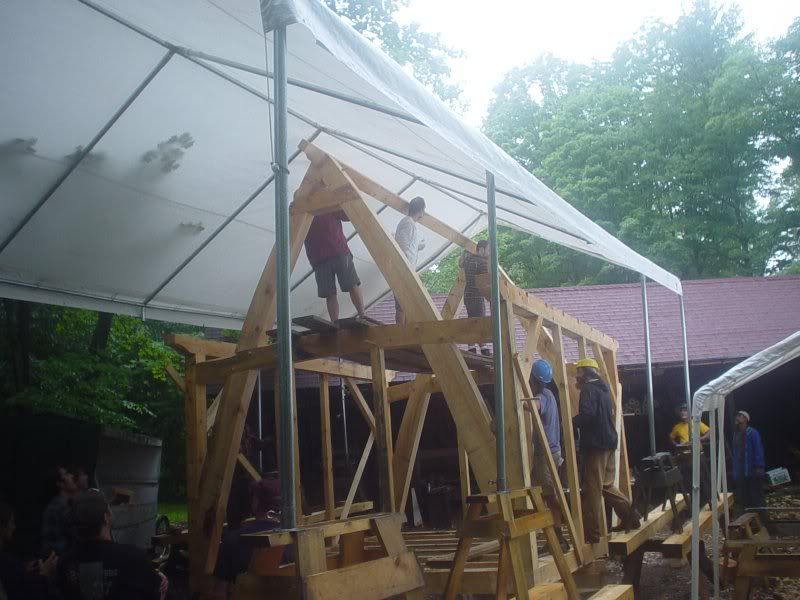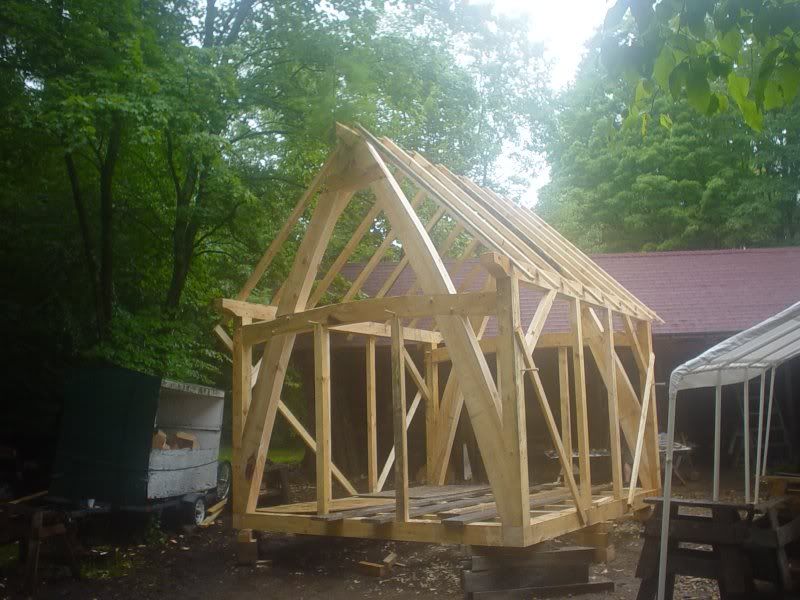|
 Structural ridge in historic frameworks
#25049
01/07/11 02:38 AM Structural ridge in historic frameworks
#25049
01/07/11 02:38 AM
|
Joined: Mar 2005
Posts: 77
Ron Mansour
 OP
OP
Member
|
OP

Member
Joined: Mar 2005
Posts: 77 |
Hello all,
I have always been under the impression (mistaken?) that a structural ridge beam is a relatively new addition to TF design, riding the coat-tails of the craft's revival in the 70's.
I happened to be thumbing through the "Red Book" the other day, and on pg. 141, Sobon mentions the presence of a "full length ridge beam" in a 1770's English barn in Western Mass. And it got me to thinking.....
My question: Just how common (or not) were ridge beams in the historic frameworks (houses/barns) of Colonial New England?
I live in an area of N.E. Ohio, the Connecticut Western Reserve, that was settled in the very early 1800's by those leaving New England, and although my viewing opportunities have been limited, I've never seen a ridge beam employed in any of the old frames around here.
So, is there much historic relevance to the ridge beam in house and barn frames of the past, or is it more a part of modern design?
Thanks to all of you who would like to contribute.
|
|
|
 Re: Structural ridge in historic frameworks
#25054
01/07/11 03:45 AM Re: Structural ridge in historic frameworks
#25054
01/07/11 03:45 AM
|
Joined: Dec 2007
Posts: 1,882
TIMBEAL

Member
|

Member
Joined: Dec 2007
Posts: 1,882 |
The "Red Book" being Timber Frame Joinery and Design Workbook?
If so, the ridge spoken of was not much for structural support. From my understanding a ridge beam was used here and there. I don't see many in down east Maine. A true structural ridge would be supported via a post system, and not allowing the peak to drop. These older type of ridge beams, mentioned, were more to fasten the rafter to, not necessarily to hold the ridge/peak up, they would still exert thrust to the walls.
The next lower down type of historical framing could be the crown post and plate configuration. Still not found in the new world much?
I would say a structural ridge with a post support system would lean toward more modern framing typology.
|
|
|
 Re: Structural ridge in historic frameworks
#25063
01/07/11 05:24 PM Re: Structural ridge in historic frameworks
#25063
01/07/11 05:24 PM
|
Joined: Mar 2005
Posts: 77
Ron Mansour
 OP
OP
Member
|
OP

Member
Joined: Mar 2005
Posts: 77 |
Tim,
Thanks for the response, and sorry for the lack of clarification concerning the "red book". Yeah, I was referring to the Guild's J & D workbook.
What you describe in your second paragraph matches up with what Sobon goes on to describe, that the commons were tenoned into this ridge and bear on the plate.
This led to a few more questions.
1) Why weren't these ridge beams posted?
2) If these non-posted ridges did nothing to alleviate thrust at the plate, why did the old builders use them, and why not simply m&t the commons to each other?
I'm sure there were some structural benefits that I'm just not seeing.
|
|
|
 Re: Structural ridge in historic frameworks
#25064
01/07/11 06:14 PM Re: Structural ridge in historic frameworks
#25064
01/07/11 06:14 PM
|
Joined: Dec 2007
Posts: 1,882
TIMBEAL

Member
|

Member
Joined: Dec 2007
Posts: 1,882 |
I have used them on occasion. I found the assembly, perhaps easier than common rafter without a ridge. You are only putting one rafter up at a time, it also aligns the rafters to the proper spacing. I sometimes wonder if cutting a simple mortice in a ridge piece is easier than the tongue and fork, I often cringe when I have a bunch of tongue and forks to do, but don't mind so much a line of mortices and short simple tenons. So my guess would be that building with a ridge could perhaps be easier. But then we don't see a majority of them, do we?
If thrust was handled in other ways such as the dropped tie then they found no need to support the ridge. Have an engineer size a true structural ridge and you will find it to be a large timber. This could also be part of the reasoning not to use one. K.I.S.S. kind of thing.
I am hoping others will add to this......
|
|
|
 Re: Structural ridge in historic frameworks
#25069
01/08/11 12:15 AM Re: Structural ridge in historic frameworks
#25069
01/08/11 12:15 AM
|
Joined: Nov 2003
Posts: 687
Gabel

Member
|

Member
Joined: Nov 2003
Posts: 687 |
My understanding (based on a conversation with Jack Sobon)is that these ridge beams were not intended to be "structural" like a posted ridge is.
They facilitated the scribing process by allowing you to lay up each roof plane as a unit with wall plate, ridge, and half the commons. This way to layout and cut the roof you only need to do 2 fairly quick and easy layups. A pentagonal ridge makes this a snap as you have one of the sides to level.
Otherwise, if each rafter joined it's opposite rafter at the peak you would have to lay up each set of commons which might require a dozen or two layups and you still haven't gotten the rafter-plate joint. So you would need to still lay up each of the roof planes. Therefore, adding the ridge eliminated quite a bit of mucking about with the rafters and kept it to two simple layups.
I believe this type of ridge fell out of use with the advent of the square rule which is pretty good circumstantial evidence to support this theory.
I always thought they would be a real pain to assemble.
|
|
|
 Re: Structural ridge in historic frameworks
#25070
01/08/11 12:27 AM Re: Structural ridge in historic frameworks
#25070
01/08/11 12:27 AM
|
Joined: Dec 2007
Posts: 1,882
TIMBEAL

Member
|

Member
Joined: Dec 2007
Posts: 1,882 |
Thanks, Gabel. I have been playing with Plumb Line Scribe on a small project, and I am now going to add a ridge to it for the reason you pointed out. I had been wondering how the rafter peaks were going to scribe in and this answers the question in the back of my mind. So both the plate and the ridge are set to the lines on the floor and scribed, accommodating both sides with the same lines, too.
I just hold the ridge up with an additional gin pole while the rafters are poked in place. So assembling is a breeze.
|
|
|
 Re: Structural ridge in historic frameworks
#25071
01/08/11 02:34 AM Re: Structural ridge in historic frameworks
#25071
01/08/11 02:34 AM
|
Joined: Feb 2006
Posts: 718
Dave Shepard

Member
|

Member
Joined: Feb 2006
Posts: 718 |
I've been thinking about ridge beams a bit lately for a small shed I'm pondering. I'll try to remember to ask Jack when he comes down on Tuesday to the shop. I've seen a few ridge beams here in Western Mass., except for one 1765 barn, I don't really recall what age groups these barns would have been in. In the Heartwood Cruck class of '09 we used a ridge beam. I think that is why we could small rafters.  
Member, Timber Framers Guild
|
|
|
 Re: Structural ridge in historic frameworks
#25073
01/08/11 10:08 AM Re: Structural ridge in historic frameworks
#25073
01/08/11 10:08 AM
|
Joined: Mar 2002
Posts: 961
Ken Hume

Member
|

Member
Joined: Mar 2002
Posts: 961 |
Hi Dave,
Cruck and king post roofs are two notable exceptions where the ridge is recognised as being very much a structural load carrying member. As in the cruck photo above we can see that up to half the roof load will head straight to ground via the cruck blades. The actual share will be dependant upon the flexure of the ridge and the type of joints or pegging arrangement employed between rafters and ridge.
Regards
Ken Hume
Looking back to see the way ahead !
|
|
|
 Re: Structural ridge in historic frameworks
#25076
01/08/11 12:26 PM Re: Structural ridge in historic frameworks
#25076
01/08/11 12:26 PM
|
Joined: Dec 2007
Posts: 1,882
TIMBEAL

Member
|

Member
Joined: Dec 2007
Posts: 1,882 |
Interesting, in my little cruck frame I have noticed the crucks have shrunk away from the ridge beam, in effect the rafters are holding the ridge up not the crucks. The crucks are spruce, and such, they tend to shrink a lot. It is configured similar to the one Dave referenced. Now if the walls were to spread via the thrust of the rafters the ridge would then settle back onto the crucks, I hope that does not happen.
|
|
|
 Re: Structural ridge in historic frameworks
[Re: TIMBEAL]
#25081
01/08/11 05:12 PM Re: Structural ridge in historic frameworks
[Re: TIMBEAL]
#25081
01/08/11 05:12 PM
|
Joined: Mar 2002
Posts: 961
Ken Hume

Member
|

Member
Joined: Mar 2002
Posts: 961 |
Hi Tim, That is a very interesting observation and I suppose one that is entirely understandable and predictable. You have probably identfied first hand the real reason why ridges are not generally employed in common rafter roofs. The ridge also stops the rafters from racking and so it is not an entirely redundant component. Did you provide a collar and peg your rafters to the ridge using square pegs driven through the rafter and ridge ideally from opposite sides on each alternate rafter couples ? I am providing a link to a photo of a 4 sided ridge found on a truncated cruck frame that is located in North East Hampshire that was dendro dated to 1404. 4 sided cruck ridge Thank you for that valuable practical insight. Regards Ken Hume Regards Ken Hume Regards
Looking back to see the way ahead !
|
|
|
|
|